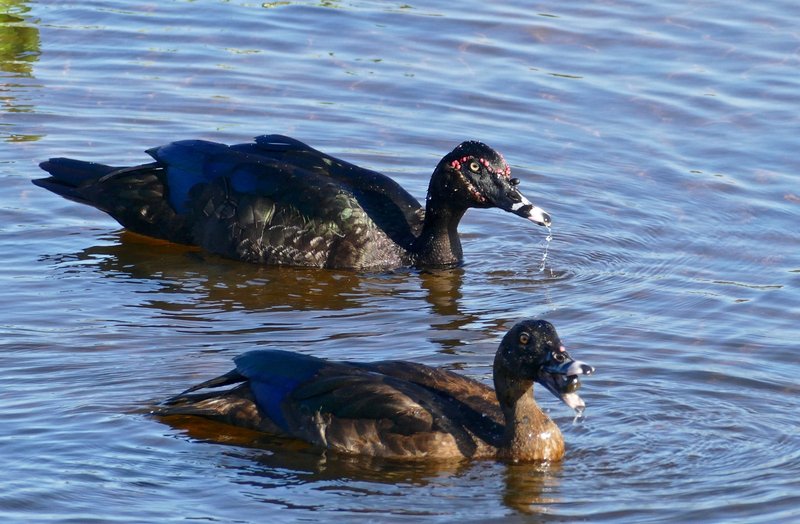
Imagine sitting down with a warm cup of coffee, ready to chat about those fascinating creatures that often wander around our neighborhoods, parks, and farms. The Muscovy duck, with its bold coloration and charismatic personality, isn’t just a pretty face. It’s woven into the cultural fabric of many regions, carrying stories and traditions that might surprise you.
Let’s dive into the world of the Muscovy duck and explore how this unique bird plays a role in local cultures and folklore. You might be wondering, “What makes these ducks so special?” Well, you’re in for a treat!
Origins and Characteristics of the Muscovy Duck
The Muscovy duck, or *Cairina moschata*, is native to Central and South America. It’s a bit of an oddball in the duck family, as it doesn’t quite fit in with the typical “quacking” crowd. Instead, it has a softer, more hissing sound, which might remind you of a cat. Its unique vocalizations set the stage for its presence in various cultures.
One of the most notable features of the Muscovy duck is its striking appearance. They come in various colors, including black, white, and a mix, often displaying iridescent feathers that shimmer in the sunlight. Their bright red facial caruncles (those funky, fleshy bumps) make them stand out, almost like they’re wearing a badge of honor. This distinctive look has made them symbols of beauty and uniqueness in different cultures.
In many regions, these ducks are domesticated, thriving in backyards and farms. They’re valued for their meat and eggs, contributing to local diets. In fact, the Muscovy duck’s adaptability to various environments has helped it integrate into diverse local traditions, from culinary practices to folklore.
Cultural Significance in Central and South America
In Central and South America, the Muscovy duck holds a special place in various indigenous cultures. For example, among the Maya, these ducks were often associated with agricultural abundance and fertility. It’s not uncommon to find tales where Muscovy ducks symbolize prosperity, thanks to their ability to thrive in different conditions.
In some regions, these ducks are released during harvest festivals as a gesture of gratitude to nature for a bountiful crop. They represent a connection to the land and the cycles of life—a reminder of the harmony between humans and nature. Honestly, it’s heartwarming to see how a simple duck can embody such significant cultural themes.
Moreover, Muscovy ducks are sometimes featured in local folklore. Tales of trickster ducks or wise birds can be found in various cultures, with stories that impart valuable life lessons. For instance, some tales emphasize the importance of community and cooperation, teaching children the value of working together, just like ducks often do in flocks.
Folklore and Myths Surrounding Muscovy Ducks
The folklore surrounding Muscovy ducks is rich and varied, often reflecting the environments in which they live. In some cultures, they are seen as messengers, bridging the human and spirit worlds. If you’ve ever heard legends about animals guiding humans or delivering messages, you might find Muscovy ducks woven into those stories as well.
In certain African traditions, these ducks are believed to possess protective qualities. They’re thought to ward off evil spirits, making them valuable companions in households. Just imagining a family gathering around a Muscovy duck for protection adds a unique charm to its role in folklore.
There are also playful stories about the Muscovy duck’s behavior. Known for their quirky antics, they often become the subject of humorous tales, showcasing their cleverness and curiosity. You might hear tales of a mischievous Muscovy duck outsmarting a farmer, bringing laughter and joy to the community.
The Role of Muscovy Ducks in Modern Culture
In today’s world, the Muscovy duck has also found its way into modern culture. They often appear in art, literature, and even social media, representing various themes from nature and sustainability to community and humor. You might find some beautiful paintings or photographs of these ducks that capture their unique essence.
They’re also a popular choice among urban farmers and homesteaders. Their adaptability and calm demeanor make them great companions for those looking to raise ducks. Honestly, they’re like the chilled-out friends of the poultry world, getting along with other birds and animals while still adding a splash of personality to any farm.
Social media has played a significant role in sharing the charm of Muscovy ducks. People love posting pictures of them waddling around gardens or interacting with other animals. You might be scrolling through your feed when suddenly you see a fluffy Muscovy duck stealing the spotlight—and who wouldn’t smile at that?
Muscovy Ducks in Cuisine and Culinary Traditions
The Muscovy duck isn’t just a pretty face or a beloved character in folklore. Its meat is a delicacy in many cultures, appreciated for its rich flavor and leaner composition compared to other duck breeds. In regions where they are commonly raised, you can find traditional recipes highlighting Muscovy duck in various dishes.
For example, in some Latin American cuisines, Muscovy duck is often roasted or used in stews, with recipes passed down through generations. The meat’s unique taste adds depth to these dishes, making them a staple for family gatherings and celebrations. Imagine a festive dinner table loaded with deliciously prepared Muscovy duck, creating delightful memories around food.
Additionally, their eggs are considered a delicacy, featuring a creamy texture and a robust flavor. You might find them served in local dishes or enjoyed as a unique ingredient in home-cooked meals. The Muscovy duck’s contributions to cuisine further solidify its cultural significance.
The Muscovy Duck in Art and Literature
Throughout history, the Muscovy duck has made its mark not just in kitchens but in art and literature as well. Artists have often drawn inspiration from their striking appearance, using them as subjects in paintings, illustrations, and photography. Whether it’s a serene landscape featuring a group of Muscovy ducks or a whimsical illustration in a children’s book, their unique features add a touch of charm to creative works.
In literature, these ducks sometimes pop up in folklore, fables, and poems. They may be cast as characters that teach lessons or evoke emotions. By incorporating Muscovy ducks into storytelling, authors tap into their rich cultural associations and relatable traits, resonating with readers across generations.
You might even stumble upon poems or short stories that celebrate the beauty of Muscovy ducks, weaving their essence into life’s little moments. It’s quite fascinating how a simple duck can inspire creativity and imagination in various ways.
Conservation and Preservation Efforts
As our world evolves, so do the challenges faced by many animal species, including the Muscovy duck. While they’re adaptable, conservation efforts are important to ensure their populations remain healthy. Habitat loss and environmental changes can impact their numbers, making it essential to support initiatives focused on preserving their natural environments.
Local communities often play a crucial role in these efforts. Educating farmers about sustainable practices and encouraging the responsible raising of Muscovy ducks can help maintain a balance in ecosystems. You might find community programs that promote awareness about the importance of preserving local wildlife, inspiring people to appreciate these ducks beyond their culinary value.
Moreover, engaging with local conservation groups can be a heartwarming way to contribute. Whether it’s through volunteering or simply spreading the word about the importance of protecting these unique birds, every effort counts. By supporting conservation, we honor the Muscovy duck’s role in our cultures and folklore while ensuring future generations can experience their charm.
As we explore the role of the Muscovy duck in local cultures and folklore, it’s clear that they are more than just a common sight in parks or farms. They carry rich stories, embody cultural values, and inspire us in many ways. Whether through their unique characteristics, culinary contributions, or roles in folklore, Muscovy ducks remind us of the beauty and complexity of nature.
So, the next time you see a Muscovy duck, take a moment to appreciate its quirks and the stories it might hold. After all, it’s not just a simple bird; it’s a unique thread in the rich tapestry of cultural history.

